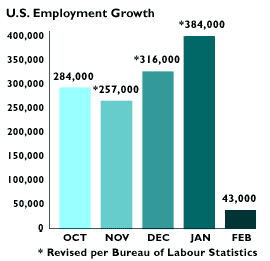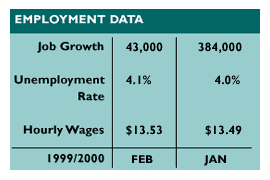|
Job growth takes a break
|
 |
March 3, 2000: 8:47 a.m. ET
Job creation below forecasts at 43,000 in February; jobless rate at 4.1%
By Staff Writer M. Corey Goldman
|
NEW YORK (CNNfn) - U.S. companies hired workers at the slowest pace in nine months in February, while wages remained subdued and the jobless rate edged up a notch, the government reported Friday -- all evidence for investors that the torrid pace of the U.S. economy may be starting to slow.
The economy created 43,000 jobs last month, the Labor Department reported, significantly below forecasts of a 235,000 gain and well below the revised 384,000 positions created in January. Average hourly wages, a closely watched harbinger of inflation, rose 4 cents to $13.53 an hour, a gain of 0.3 percent that was in line with forecasts. The unemployment rate rose to 4.1 percent from 4 percent in January.
For Main Street, the report indicated that the furious pace of job creation that has helped catapult the U.S. economy through its best period of growth in more than three decades is beginning to taper off. For Wall Street, the report suggested that the Fed's recent spate of rate increases is beginning to have the desired effect of slowing economic growth and keeping inflation in check.
"Although this is bad news for Main Street this is very good news for Wall Street," Art Hogan, chief economist with Jeffries & Co., told CNNfn. "What it says to Mr. Greenspan is that you're doing your job and it's working. Now stop doing your job and give us a break in the second half of the year." (338KB WAV) (338KB AIFF)
Main Street vs. Wall Street
Stocks surged as the opening bell rang on Wall Street, with investors concluding that the economy is finally begin to exhibit signs of slowing, ensuring that further interest rate increases from the Federal Reserve will be limited. Although the Treasury market registered gains, the response was muted, with both the 10-year and 30-year bonds registering limited reaction to the numbers.
 Both Wall Street economists and Fed officials, including Greenspan, have repeatedly expressed concerns that the robust U.S. job market -- which has led to a shrinking pool of workers available to produce the surging quantity of goods and services U.S. consumers demand -- could spark faster inflation. Both Wall Street economists and Fed officials, including Greenspan, have repeatedly expressed concerns that the robust U.S. job market -- which has led to a shrinking pool of workers available to produce the surging quantity of goods and services U.S. consumers demand -- could spark faster inflation.
Indeed, at a time when "pre-IPO" has become common verbiage in job descriptions, and companies are offering perks ranging from free gym memberships to sports cars to entice skilled workers, investors and some policy makers have expressed concerns that wages eventually will accelerate.
But today's report didn't show any of that. On the contrary, wages remain subdued and the percentage of Americans without a job actually rose for the first time in seven months. That suggested to analysts and investors that the Fed's four quarter-point rate increases since June 1999 are beginning to have their desired effect: slowing the economy down from its torrid 6.9 percent pace.
Relax, Alan
"It's too early to call a turn in the trend, so Alan Greenspan can't relax completely, but it's certainly the kind of report that will help him sleep better," said Bill Cheney, chief economist with John Hancock Financial Services. "There's still no sign of wage inflation and we seem to be heading for a soft landing: a smooth slowdown into sustainable non-inflationary growth."
Higher wages can lead to inflation as companies pass their higher costs on to consumers in the form of price increases. But some economists and policy makers say the growing use of computers, the Internet and other technology has allowed workers to produce more per hour, allowing companies to hold the line on prices, thus keeping a lid on inflation.
The Fed has been on the inflation warpath since last June, lifting short-term rates in quarter-point increments to boost the cost of borrowing and discourage a consumer-spending spree, while trying to encouraging saving. The last move came Feb. 2, when its policy-setting arm lifted its benchmark Fed funds rate to 5.75 percent.
While today's report was greeted with unbridled enthusiasm on Wall Street, almost no analysts or investors expect the Fed to put their rate-rise plans on hold at their March 21 policy meeting, particularly with other economic evidence pointing to robust economic growth and small pockets of inflation.
Signs of slowing?
"We think the relief is temporary; no other data supports the slowdown story," said Ian Shepherdson, chief U.S. economist with High Frequency Economics. Today's report indicates "either statistical noise, or the start of a real slowdown. Given all the other evidence, we favor the former," he said.
 Surging manufacturing output, rising income and spending activity, and strong fourth-quarter economic output has all pointed to an economy that's growing too quickly for its own good. At the same time, recent numbers showing stable prices, declining durable goods orders and falling home sales indicate that some areas of the economy are starting to show signs of fatigue. Surging manufacturing output, rising income and spending activity, and strong fourth-quarter economic output has all pointed to an economy that's growing too quickly for its own good. At the same time, recent numbers showing stable prices, declining durable goods orders and falling home sales indicate that some areas of the economy are starting to show signs of fatigue.
February's employment growth was muted by a decline in construction and service industry positions. The construction industry shed 26,000 jobs last month after a building-boom-induced 116,000 gain in January. Service-related employment rose by 6,000, after a 142,000 surge a month before.
Factories added 5,000 jobs after a gain of 21,000 in January. And the government added 13,000 positions last month as the U.S. Census Bureau continued hiring for its 2000 Census. Census needs about 500,000 new employees by April to help carry out its population count. The pool of available workers rose 2.4 percent to 10.18 million.
Factory orders decline
Other numbers indicating a drop in factory orders, stable output at service-related companies and a decline in consumer sentiment helped reinforce the view that the U.S. economy may be losing some of its muscle.
The Commerce Department reported that orders at U.S. factories declined 1.1 percent in January, a bigger decline than the 0.5 percent drop expected by analysts and well below December's 3.8 percent gain. January's dip marked the sharpest decline since a 1.4 percent contraction in April of 1999.
Also, the University of Michigan's final consumer sentiment index for February fell to 111.3 from an all-time record high of 112.0 final in January, U.S. market sources said. The current conditions component also fell slightly to a final reading of 116.8 in February from a final reading of 117.3 in January. The index is only released to subscribers.
Finally, the National Association of Purchasing Management said its index of non-manufacturing activity rose to 58.0 in February from 52.5 in January, which suggests that services-related output is on the rise. A reading above 50 indicates expansion, while a reading below 50 suggests the opposite. 
|
|
|
|
|
 |

|

